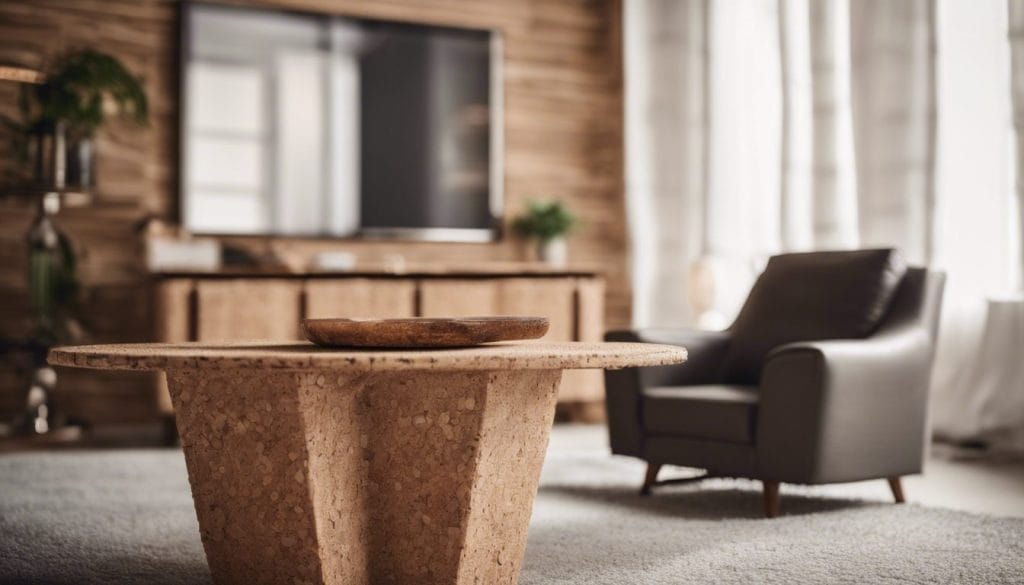As you consider updating your home’s decor, have you thought about the impact of your furniture choices on the environment?
Eco-friendly furniture isn’t just about looks; it’s about making decisions that align with your values of sustainability. You can choose pieces made from materials like reclaimed wood or recycled plastic, which not only reduce waste but also lessen the demand for virgin resources.
Just as important, by supporting brands that adhere to ethical labor practices and sustainable manufacturing processes, you’re contributing to a larger movement towards environmental responsibility.
Isn’t it intriguing to think that your next couch or dining table could help essemble the way for a greener future?
What Sustainable Materials to Choose

When you’re choosing eco-friendly furniture, consider materials like:
- Bamboo
- Reclaimed wood
- Organic cotton
- Cork
- Recycled plastic
These options not only support sustainable practices but also offer durability and seriously, they can look awesome!
Bamboo

Bamboo, a highly sustainable material, grows quickly and offers remarkable durability and ease of maintenance, particularly suited for kitchen essentials like countertops and cutting boards. You’ll find it’s a great choice for your eco-friendly home because it’s not only tough but also easy to clean.
Unlike traditional hardwoods, bamboo can regenerate without replanting and matures in just a few years, making it an exemplary resource for sustainability. It’s ideal for busy kitchens where you need surfaces that withstand constant use yet remain hygienic.
Plus, bamboo’s natural aesthetic can complement any decor style, adding a touch of elegance while maintaining an eco-conscious footprint. When you choose bamboo, you’re opting for a material that supports both the environment and your lifestyle.
Reclaimed wood

Reclaimed wood, salvaged from old buildings and structures, not only prevents unnecessary deforestation but also adds a distinct, rustic appeal to your home.
This material typically comes from sources like barns, warehouses, railroads and decommissioned factories, and carries with it a history that newer materials can’t match.
You’ll find that reclaimed wood is often of higher quality than newly harvested wood. This is because it originates from old-growth trees, which had decades to grow and therefore developed a tighter, more durable grain.
Opting for reclaimed wood not only helps you maintain an eco-friendly lifestyle but also ensures that you’re investing in furniture that’s robust, full of character, and has a story to tell. It’s a choice that looks good and feels good.
Organic cotton

Choosing organic cotton for your home textiles allows you to reduce environmental harm, as it’s grown without the use of pesticides or synthetic fertilizers.
This sustainable material isn’t just kinder to the planet; it’s also a healthier choice for your family. Without harsh chemicals, organic cotton production supports cleaner water and air, promoting biodiversity.
You’ll find that textiles made from organic cotton, such as bedding, towels, and upholstery fabrics, are supremely soft and durable.
When you choose organic cotton, you’re supporting farming practices that maintain soil health and reduce pollution. Every purchase can drive the demand for more sustainable farming methods, making a positive impact on the environment.
Cork

Cork, harvested from the bark of cork oak trees, offers an eco-friendly option that doesn’t harm the tree and can be harvested repeatedly. This remarkable material regenerates its bark, allowing for sustainable use without damaging the ecosystem.
While cork mightn’t be as durable as some other materials, its environmental benefits are significant. It’s biodegradable and recyclable, making it an excellent choice for those who prioritize sustainability in their furniture selections. Additionally, cork’s production is energy-efficient, further reducing its carbon footprint even more.
When you choose cork furniture, you’re not just making a style statement; you’re also contributing to a healthier planet. It’s a practical solution that aligns with eco-conscious living, ensuring that your furniture choices are as responsible as they’re stylish.
Recycled plastic

While cork offers significant environmental benefits, turning to recycled plastic for your furniture can also make a substantial positive impact on the planet.
Repurposed plastic isn’t only to reduce landfill. You’re keeping plastic out of the ocean, and you’re also supporting industries that innovate in recycling technologies.
Each piece of furniture you choose, made from recycled plastic, contributes to a circular economy, promoting sustainability. It’s a proactive step towards environmental responsibility that doesn’t compromise on design or functionality.
Is the Wood Legally Harvested
To guarantee the wood in your furniture is legally harvested, familiarize yourself with the relevant laws and certifications. In regions like the U.S., EU, and Australia, stringent laws prohibit the trade of illegally sourced wood.
You’ll need to ensure compliance not only with the laws of your country but also those from where the wood originates. Be vigilant about timber species listed under CITES. Some species may be completely banned or require specific permits for trade, depending on their conservation status.
Or, you could opt for wood certified by organizations like the Forest Stewardship Council (FSC), which is known for its rigorous standards in promoting responsibly managed forests and sustainable logging practices.
When you’re not sure, don’t hesitate to ask suppliers detailed questions about the wood’s origin and harvesting methods.
If they can’t provide a clear, verifiable answer, consider it a red flag.
Third-Party Certifications
It’s advisable to explore brands that have earned third-party certifications like B Corp, FSC, or Cradle to Cradle (C2C), as these labels signify a genuine commitment to sustainable practices.
These certifications guarantee that the products you’re considering are produced with ethical, transparent, and sustainable methods.
B Corp certification means the company meets rigorous standards of social and environmental performance, accountability, and transparency.
FSC (Forest Stewardship Council) certifies that the wood used is sourced from responsibly managed forests.
Cradle to Cradle focuses on safe materials and design for material reutilization.
What Else Can I Consider?
Choosing non-toxic paint can make your furniture look fantastic while also making it healthier. Standard paints can emit harmful fumes, but paint with low or no volatile organic compounds (VOCs) limits those harmful chemicals.
This makes your air cleaner and helps the planet by reducing pollution. It’s a simple adjustment that makes your space safer and helps create a healthier living environment.
How Can I Make My Interior Design More Sustainable?
Sustainable interior design is about choosing beautiful decorations while also planning a design that is sustainable for the planet. You opt for quality materials to create a suitable space to live, work, relax, and feel at home. Thus, eco-friendly furniture plays a significant role in sustainable design!

